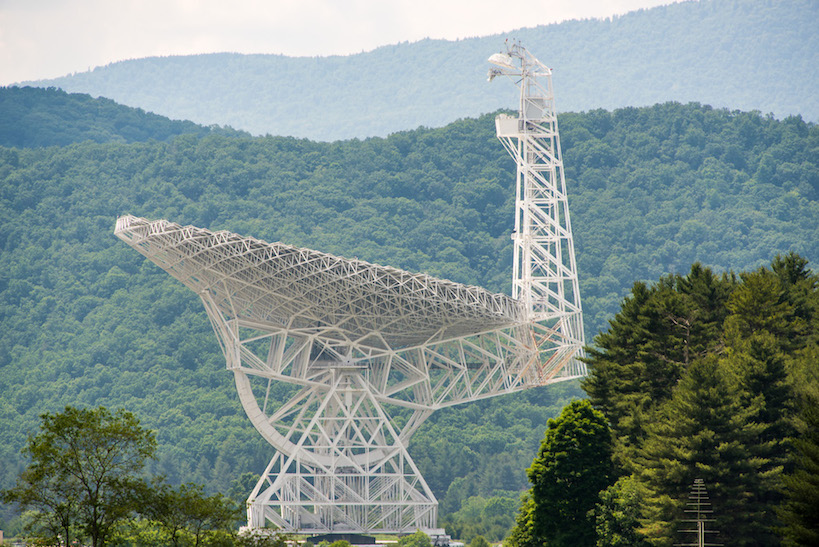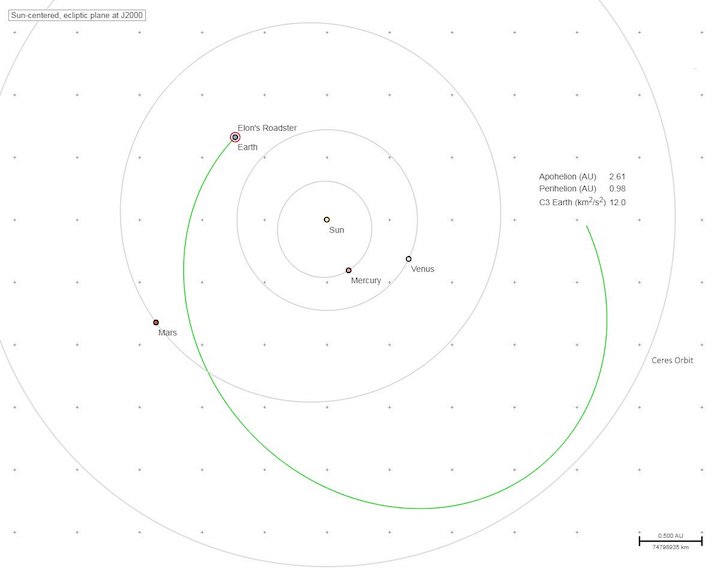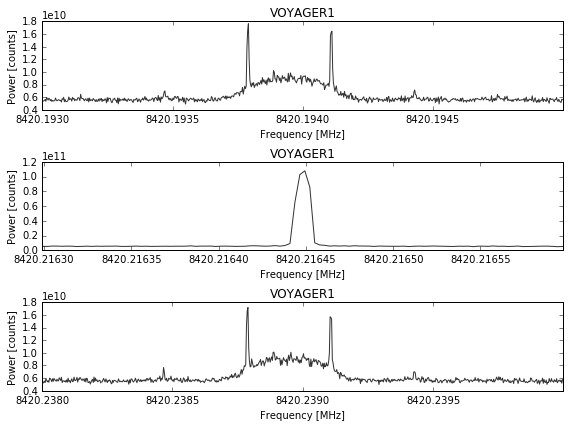Interplanetary Teslas and SETI
The recent launch of Elon Musk’s Tesla Roadster by SpaceX’s Falcon Heavy rocket got the Berkeley SETI team thinking: how detectable would a spacefaring Tesla be to the Breakthrough Listen instruments at the Green Bank and Parkes telescopes?
We recently took a look at the interstellar asteroid 'Oumuamua with our equipment at the Green Bank Telescope (GBT). While any individual target such as this is unlikely to be the holy grail that turns out to exhibit evidence of extraterrestrial technology, if we took a cynical approach to every target, we'd never look at anything. Besides, even though 'Oumuamua is unlikely to be an interstellar spacecraft, it’s important to put our system through its paces with a range of targets. It’s also fun to be able to do a quick observation of a target that’s 300 million kilometers from Earth, and still have the sensitivity to detect transmitters on the surface one tenth as strong as the typical power put out by a cellphone.
But what about that flying car? There’s not a lot of public information available regarding the specs of the technology on board, but we can do a little sleuthing and make some educated guesses.
Elon’s Roadster streamed back live video for a few hours after launch, which was picked up by ground stations on Earth, and then broadcast over the internet to watchers across the world. Permission to make these transmissions came from the Federal Communications Commission, and a filing submitted by SpaceX to the FCC gives us some idea about the power and frequency band of the transmitters they’re using.

The transmitter frequency appears to be 2.2 GHz (within range of the S-band receiver at GBT), and the power is around 20 W. In contrast to narrow-band signals that we typically look for in a SETI search (the motivation here being that such signals are more efficient if one were designing an interstellar beacon), the downlink puts out a signal covering a broader range of frequencies. Let’s assume the bandwidth is 3 MHz, to accommodate the video stream which is a few Mbit / s. This is 1 million times the 3 Hz bandwidth for a typical SETI search; the signal to noise goes down by the square root of the bandwidth, so we lose a factor of about 1000.
However, the transmitter is 250 times the minimum (isotropic, narrow-band) power (0.08 W) that the 'Oumuamua observations could have detected. So the signal would appear 250 / 1000 = about 1/4 as strong to our instrument at GBT. The inverse square law means that we could therefore detect the Tesla downlink to half the distance to 'Oumuamua, or 1 astronomical unit (1 AU is the distance from the Earth to the Sun, which is 93 million miles).

The Tesla is expected to get out to 2.6 AU from the Sun, i.e. at most 3.6 AU from Earth. So our back-of-the-envelope calculations suggest that we’d need to increase the length of time we integrate on the target to several hours (our observations of 'Oumuamua were broken into 5 minute blocks) to detect it in the outermost parts of its orbit. Also, although we could detect it, we'd need yet longer integrations to get sufficient signal strength to actually decode the information transmitted. This is all hypothetical though; the transmitter turned off a few hours after launch, when the Tesla’s batteries ran out.
Anyway, this is a good sanity check. It means SpaceX could pick up the downlink signal, when the spacecraft was just a few hundred thousand kilometers from Earth, with high fidelity using antennas that are much smaller than the GBT (which is the largest steerable radio dish in the world).
Newer Teslas like the Model S are known for their autopilot capabilities, and part of this system involves the use of a radar to scan for obstacles on the road ahead. So what if instead of launching a Roadster with a live video stream, Elon had chosen to send a Model S, and left the radar on as the car coasted through space? Not much use for avoiding any asteroids that might cross its path, but could we pick it up with the GBT?
Again, getting precise details from publicly available sources is a bit challenging, but it looks like the radar chips operate at a frequency of 77 GHz. The power output of the radar system (including antenna gain) looks to be about 10 W, and the signal bandwidth is probably around 100 MHz. This gives us a signal strength about 2% of the limiting value for 'Oumuamua at 2 AU. Additionally, the GBT is a factor 10 less sensitive at 77 GHz than at 2 GHz. So we could see the Tesla radar if it was about 20 times closer than 'Oumuamua, or about 15 million kilometers from Earth. At the time of writing this blog, the Roadster was about 1 million kilometers from Earth, so it would theoretically be close enough to detect if it had autopilot switched on.
As we discussed above, though, the Roadster isn’t actually equipped with autopilot. Even if it was, the car couldn’t exactly use it to steer around any obstacles - wheels aren’t much use in space, and the radar is (unsurprisingly) not configured optimally for working over interplanetary distances. If you want to know if there are any asteroids headed your way, you’d be better off using the Arecibo Planetary Radar.

But if we wanted to reconfigure the Tesla to be a more effective interplanetary probe, how might we do that? As it happens, we’ve already used the Breakthrough Listen instrument at the GBT to make observations of the Voyager 1 spacecraft. At 20 billion kilometers from Earth, it’s the most distant object that humans have launched into space. Its transmitter has a power of just 20 W, but it uses a high-gain antenna (with a gain measured in the hundreds of thousands) to beam this power in the direction of Earth. It also packs the signal into just a few tens of Hz bandwidth (which as we note above is much better for detectability at long distances). As a result, this plucky probe is clearly detectable by the GBT (although the data rates are a little low - we’re talking tens of bits per second here). If you know a little Python, you can have some fun exploring real data from our GBT detection of Voyager yourself.
At Breakthrough Listen, we’re not in the business of launching things into space (although our friends at Breakthrough Starshot are working on a mission that would leave the Falcon Heavy in the dust). But we’re thrilled to see what SpaceX has accomplished with this latest launch, and we’re excited about the journey of discovery enabled by new technologies. We’re hopeful that some day soon, our telescopes will detect more than just artificial (albeit Earthly) technologies like Voyager 1, or exciting astrophysical phenomena like fast radio bursts. As the most powerful SETI search yet undertaken, we’re humanity’s best chance to find evidence that a civilization that arose on a world orbiting another star has developed technological capabilities like ours. Maybe even flying cars.
